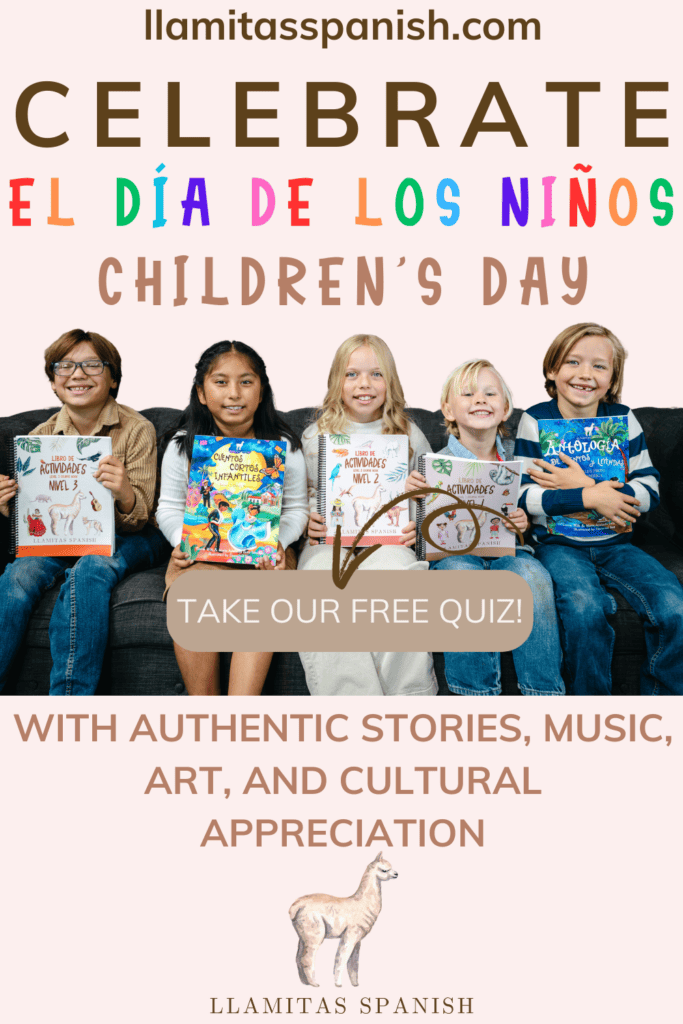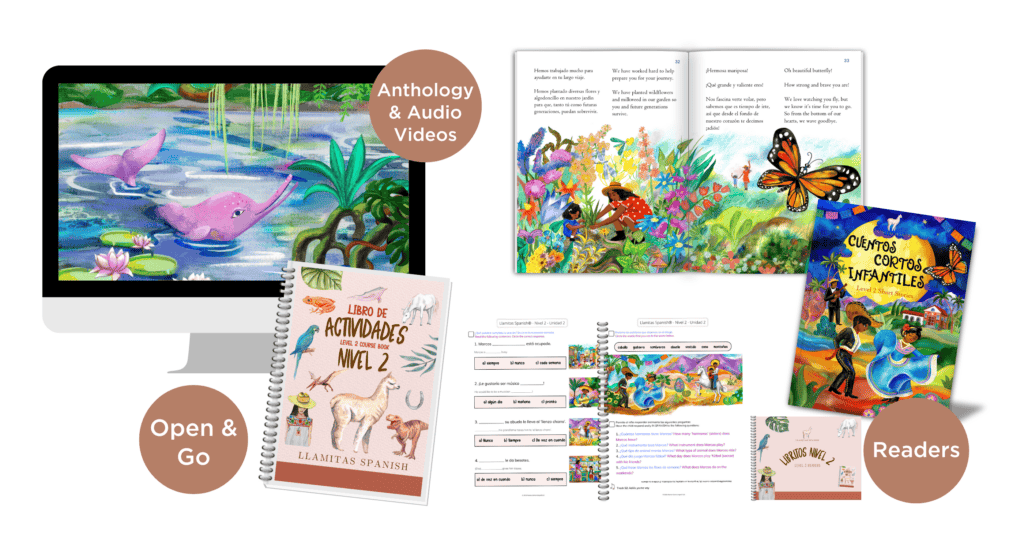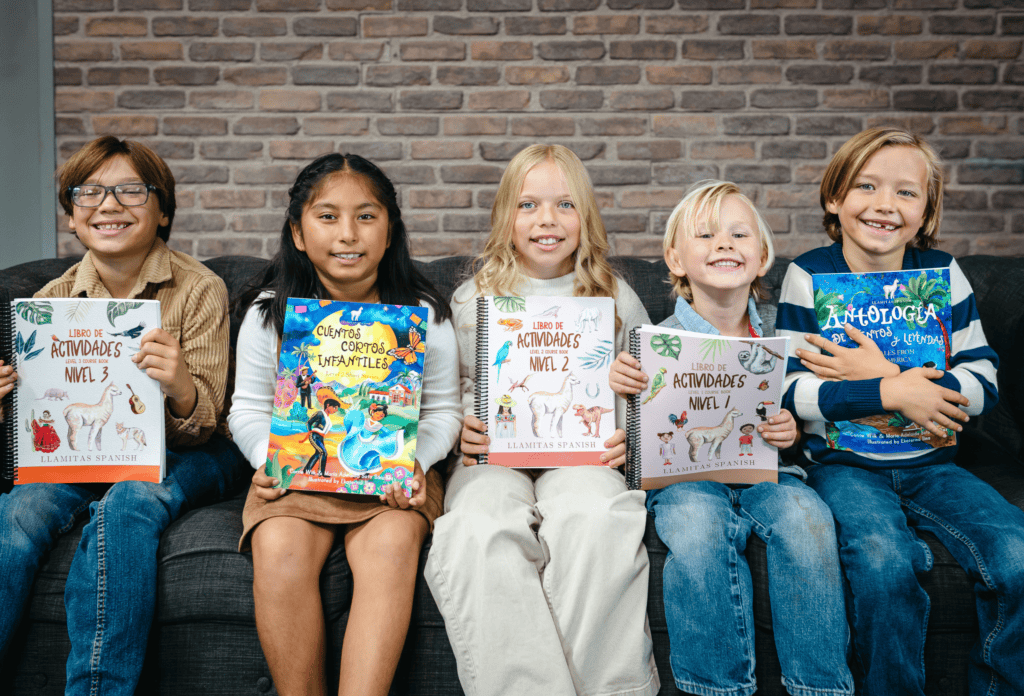In this post: Learn all about the Hispanic holiday El día de los niños, or Children’s Day, so you can celebrate with your kids.
In our fast-paced world, it’s not always easy to slow down and spend quality time with our children. Between school, sports, and extracurricular activities, many families (like mine) have a full schedule every day of the week.
As great as it is to be able to support our kids’ many interests and passions, simply being together every once in a while is important too. It gives you a chance to connect and create lasting memories, reminding our kids that they are loved and appreciated.
This is what El día de los niños, or Children’s Day, is all about.

At Llamitas Spanish, we support children’s education and biliteracy through our Spanish curriculum levels. We love to help you give your children a culturally authentic bilingual education by providing you with all of the tools and resources you need.
With that in mind, let’s learn more about El día de los niños and how you can celebrate with your children!
Table of Contents
What is Día de los niños?
Many countries around the world celebrate Children’s day, or Día de los niños. Also sometimes called Día del niño, this holiday is all about celebrating children and childhood.
While the meaning and significance of this holiday can vary by country, Día de los niños is an important holiday in many Latin American countries, including Mexico.
Día de los niños is a day to recognize the importance of children’s education, safety, and happiness. In many countries, it’s also a celebration of children’s literacy and culture.
The holiday raises awareness for some of the unique challenges children face as well, with a focus on children’s rights, protection, and wellbeing.
Children and family are often highly valued in Hispanic culture, and Día de los niños serves as a reminder to care for and nurture the next generation as they grow up.
Related post: Holidays in Spanish Speaking Countries
When is El día de los niños?
Día del niño in Mexico is celebrated on April 30th.
However, Children’s Day is celebrated at different times of the year depending on the country. Even other Spanish-speaking countries celebrate Día de los niños at different times. Here are just a few examples:
- Spain: second Sunday in May
- Guatemala: October 1
- El Salvador: October 1
- Honduras: September 10
- Nicaragua: June 1
- Ecuador: June 1
There is also a World Children’s Day celebrated on November 20th globally. This is not the same as Día del niño, though it shares the purpose of raising awareness for children’s rights and wellbeing.
Children’s Day Celebrations
Children’s Day is celebrated differently around the world and can include many different traditions, but it’s all about treating children to a special day.
In Mexico, teachers often plan special activities for their students for Día del niño. These might include games, food, music, and piñatas. Communities and organizations will also plan special events and activities planned for children as part of the Día de los niños celebration.
Parents may take their children out for a special day, like a trip to the museum, zoo, beach, or park. Eating special treats like chocolate, cakes, candy is often a part of the festivities, and sometimes parents will give their children presents too.
Giving is an important part of the holiday, and toys and donations are sometimes collected for less fortunate children. While Día de los niños is becoming increasingly commercial, the focus remains on treating children to a special day to show their importance.
Related post: 10 Ways to Say I Love You in Spanish
Related post: 24 Spanish Children’s Books About Love & Friendship
Celebrate Día de Los Niños with Your Kids
Planning to celebrate Día de los niños with your kids this year? The most important part of any Día del niño celebration is making your children feel loved and special!

You don’t have to spend a ton of money to celebrate with your children—spending quality time together and doing things that they enjoy is what it’s all about. Expensive gifts or outings aren’t necessary.
To get you started, here are a few ideas of how you can celebrate Día de los niños with your kids:
- Plan a special outing, like going to their favorite park, the zoo, or a children’s museum.
- Play some of their favorite games.
- Go out for a treat like ice cream or donuts, or to a restaurant they love.
- Get crafty—try making a piñata together and then let them knock it down!
- Make a playlist of their favorite Spanish songs and have a dance party.
- Have a movie night at home—watch one of their favorites in Spanish!
- Join them in doing one of their hobbies.
- Set up a cozy spot and read Spanish children’s books together.
Kids today live busy lives—and we know you’re busy too! Sometimes simply being present together is the best gift we can give.
However you choose to celebrate Día de los niños, make your children the focus of the day. Remember, you don’t have to do something big or expensive to show your love.
Homeschool Spanish Curriculum Levels
At Llamitas Spanish, we celebrate children’s education and literacy every day. We’re passionate about supporting your child’s biliteracy through authentic stories, music, art, and cultural appreciation with our homeschool Spanish lessons.
Our curriculum levels have been designed with children’s natural love of learning in mind, incorporating elements of Charlotte Mason and Montessori education in our thematic lessons. Through literature, art, games, and more, they’ll learn Spanish in context and across subjects.
- Level 1 teaches Spanish foundations to beginners ages 4–10 as they explore fun topics like animals, transportation, and even outer space.
- Level 2 is our interim level for ages 6–10 with at least one year of formal Spanish education. They’ll build on their skills from Level 1 with our beautifully illustrated short story anthology as they learn grammar in context.
- Level 3 is for intermediate learners ages 7–12. They’ll further develop their biliteracy and grammar skills through our bilingual folktale anthology as well as more advanced music, art, and cultural studies.

All of our homeschool Spanish lessons are complete with bilingual scripts for you and activities that kids love, so you don’t have to do any of the planning or prepping yourself. That means you can spend more time together AND give them a quality bilingual education that you feel good about.

